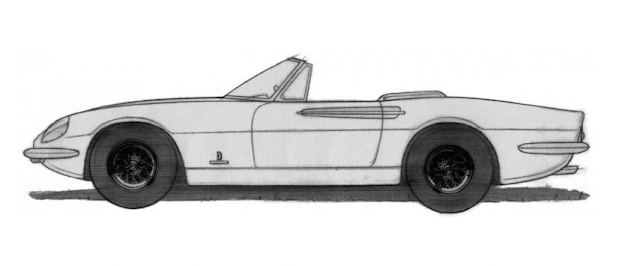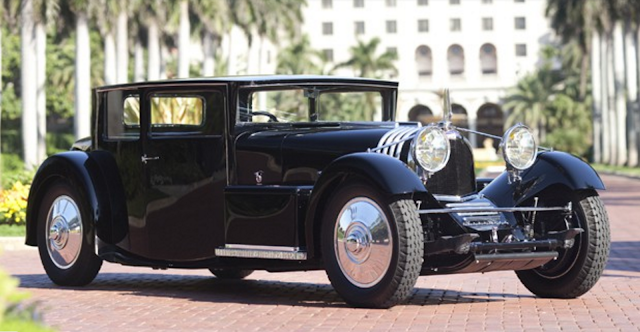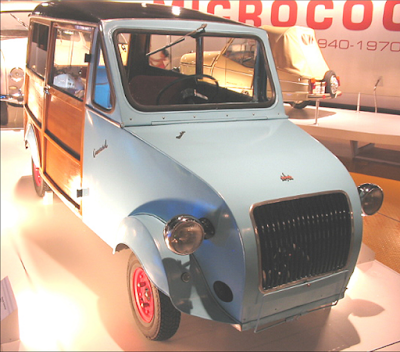American Tom Tjaarda, son of John Tjaarda, designer of the 1936 Lincoln Zephyr, was perhaps the most successful of architects ever to design a car. If success is measured in the number of cars which made it from renderings and clay models to series production, this is certainly true. Unlike most car designers with architectural training, Tjaarda actually obtained his architectural degree from the University of Michigan in 1958, and took 2nd prize in the GM Craftsman's Guild car design competition that year with his design for the Turbine Wagon shown above. He was a design consultant on the Westinghouse Time Capsule Pavilion at the 1964-'65 New York World's Fair. His car designs for Pininfarina and Ghia in Italy, however, brought him fame (at least among other car designers) in his home country. The first of these was his design for Ghia Studios for the Innocenti 950 Spider, produced by OSI using Austin Healey Sprite drivetrains from 1961 through 1970. Careful control of proportions masks the small size; the Honda S600 roadsters which appeared 3 years later have similar forms and proportions.

Tjaarda's first project for Pinin Farina (it would become one name in 1961) was the Corvair show car below. GM was interested in selling Corvairs in Europe, and the idea of a GT car had some appeal, as Corvairs were fairly large cars by European standards. The first PF Corvair* shown in 1960 had a tight, GT style cabin and curving rear fenders recalling Corvettes of 1956-'60.
The second of three PF Corvairs appeared in 1962. Here Tjaarda gives the car a stronger horizontal character line wrapping around the tail (a bit more like the production car), and proportions the greenhouse in a way that suggests a 2+2 rather than a 2 passenger car. The proportions, if not the form, prove to be predictive of the second-generation 1965 Corvairs.
Tjaarda's design for the Ferrari 330 GT 2+2 appeared in January 1964. The restrained design was aimed at the luxury grand touring car market. The car's one controversial feature was the quad lighting scheme at the front, with large headlights outboard of smaller lights set in wide, bright metal openings which Tjaarda seems to have adapted from his Corvair show cars of 1962 and '63...

For the Series II version of the car which appeared in 1965, Pininfarina produced bodies with a simplified single headlight scheme, and this version seems more popular with collectors, as is the 5 speed transmission in the Series II cars.
Tjaarda's design for the Lancia Flaminia Coupe Speciale was built in only one copy as a show car in 1963. Like the Corvair show cars, it featured a low belt line and glassy greenhouse with thin pillars. As with the '62 and '63 PF Corvairs, a strong fold in the flanks above the wheels reduced the visual height and any need for surface decoration. The trapezoidal tail lights and canted rear fender tops would show up on other Tjaarda designs, and soon.
At the front, Tjaarda deployed quad headlights well above the plane of the hood, which created a more bluff impression than the single headlight design on Zagato's Flaminia Sport then in production.

In 1963 Pininfarina obtained a new Corvette Sting Ray chassis from GM and gave Tom Tjaarda the challenge of formulating an alternative vision of this car. The Corvette Rondine* appeared in two forms, one with a reverse-slant rear window and the final version below, with a smooth, glassy roof form meeting the deck surface. While the minions of General Motors decided the show car didn't look enough like a Corvette, Pininfarina encouraged Tjaarda to use several of his formal ideas on a Fiat a couple years later...
The Fiat 124 Spider went into production in 1966 with the same horizontal fold merging with a vertical fender surface, kicking up over the rear wheels, and creating fender forms which slope down to the deck surface. The hardtop prototype shown below, which did not make production, is even more like the Rondine as it has the anodized "B"-pillars and wraparound rear window. Though Tjaarda didn't feel Fiat was serious enough about the 124 Spider, it had a more enduring presence in the US than any other Fiat model, ending production in 1985 as the Pininfarina Azzurra...
Pininfarina showed real confidence in their young designer by giving him a plum assignment at the same time as the Fiat; this was to design the Ferrari 365 California Spider produced in 1966-'67...
The scoop recessed into the door surface has a bright metal strake echoing the air intakes of the Dino 206 prototypes then being designed at Pininfarina. On the front-engined California, however, it merely provides a concealed door handle and an opening that may have channeled air to the rear brakes, or not. Only 14 of these cars were produced...
After Tjaarda returned to Ghia, one of his first projects was to design a potential series production GT car for Serenissima*, the renegade specialist car company started by Count Volpi after a disagreement with Ferrari. The mid-engined Serenissima Ghia reflected some themes explored first by Giorgetto Giugiaro on his De Tomaso Mangusta, like the sharp fold connecting the wheels, and the steep windshield. The "drilled for lightness" roll bar, an echo of Tjaarda's 1958 Turbine Wagon, was a distinctive feature, along with the prototype 4-cam, 24 valve V8. This GT car for Count Volpi remained a one off...
As did the De Tomaso Mustela below, which appeared on the show circuit in 1969. Based on a Ford V6 drivetrain, the hatchback Mustela would have made a very attractive alternative to the Capri Ford introduced in Germany and England that same year...
The Lancia Fulvia 1600 Competizione appeared at car shows in 1969, the same year Fiat took over Lancia, and explored the same themes as the Mustela, but there is less trim around the windows and an absence of bumpers, all reflecting, like the high tail with retractable air foil, the car's road rally purpose. The drilled rollover bar appears again, an example of an architect working structure into visual form...
1969 turned out to be a busy year for Tjaarda. Ghia also showed off his design for the Marica, a GT coupe based upon the decade-old Flaminia chassis. The tapered contours, crisp edges and restrained decoration would've brought the big Lancia well into the Seventies without any further updating, as the engineering was still pretty fresh. All Lancia really needed besides designs like these was money, so it could avoid the Fiat takeover. It was not to be...
What was to be was another 2 seater built by Ghia to a design by Tom Tjaarda. This was the 1971 De Tomaso Pantera, a mid-engined successor to Giugiaro's Mangusta, and overlapping it on De Tomaso's production lines. Organized around Ford's 351 Cleveland V8 and sold through Mercury dealers in the US, the car offered Maserati charisma at a Mercedes price. Along with the 124 Spider, the Pantera made the biggest and most enduring impact of Tjaarda's designs on American roads.
If Tjaarda's De Tomaso's Longchamp (above), in production 1972-'89, was an answer to the Mercedes SL and was stylistically derived from it, the Deauville sedan which appeared at the Turin Show in 1970 was derivative of Jaguar's XJ. But Tjaarda's Deauville (below) was so carefully contoured, proportioned and detailed that it did a better job of looking like a Jaguar than the XJ40 series which appeared in 1986, the year after the Deauville exited production after 244 examples were built. Ford Motor Company bought Ghia and Vignale to launch the Pantera project, and acquired a great designer of Italian cars in the process. Ironically, that designer hailed from Detroit. Tom Tjaarda went on to guide the design of several production cars, including the Ford Fiesta, and ran a successful industrial design consulting firm after leaving Ford. He died in 2017.
*Footnote: The PF Corvairs (3/18/16), Corvette Rondine (3/10/16), Lancia Fulvia GT show car (10/3/16) and Serenissima Ghia (3/20/19 & 9/7/15) are featured in previous posts in the Archives; dates posted are in parentheses. The other posts on Architect-Designed Cars were Part 1 on 5-7-17, Part 2 on 5-21-17, and Part 3 on 4-26-20.
Photo Credits
Top: invaluable.com
2nd & 5th: wikimedia
3rd & 4th: Pininfarina
6th & 7th: Lt. Jonathan Asbury, USN
8th: pinterest.com
9th, 11th & 12th: Pininfarina
10th: cartype.com
13th: Tom Tjaarda in Auto & Design Magazine
14th: wikimedia
15th thru 18th: Ghia Studios
19th & 20th: wikimedia
21st: Honest John Classics
Bottom: Ford Motor Company (1976 Fiesta)





















































